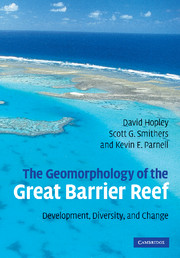Book contents
- Frontmatter
- Contents
- Preface
- Acknowledgements
- 1 Geomorphology and the Great Barrier Reef
- 2 Foundations of the Great Barrier Reef
- 3 Sea level: a primary control of long-term reef growth and geomorphological development
- 4 Oceanography, hydrodynamics, climate, and water quality as influences on reef geomorphological processes
- 5 Spatial analysis of the morphology of the reefs and islands of the Great Barrier Reef
- 6 The non-reefal areas of the continental shelf
- 7 Fringing and nearshore coral reefs
- 8 The mid-shelf reefs of the Great Barrier Reef
- 9 The coral reefs of the outer shelf of the Great Barrier Reef
- 10 Islands of the Great Barrier Reef
- 11 The accumulation of the Holocene veneer to the Great Barrier Reef
- 12 The Holocene evolution of the Great Barrier Reef province
- 13 Geomorphology's contribution to the understanding and resolution of environmental problems of the Great Barrier Reef
- References
- Geographic index
- Subject index
10 - Islands of the Great Barrier Reef
Published online by Cambridge University Press: 22 August 2009
- Frontmatter
- Contents
- Preface
- Acknowledgements
- 1 Geomorphology and the Great Barrier Reef
- 2 Foundations of the Great Barrier Reef
- 3 Sea level: a primary control of long-term reef growth and geomorphological development
- 4 Oceanography, hydrodynamics, climate, and water quality as influences on reef geomorphological processes
- 5 Spatial analysis of the morphology of the reefs and islands of the Great Barrier Reef
- 6 The non-reefal areas of the continental shelf
- 7 Fringing and nearshore coral reefs
- 8 The mid-shelf reefs of the Great Barrier Reef
- 9 The coral reefs of the outer shelf of the Great Barrier Reef
- 10 Islands of the Great Barrier Reef
- 11 The accumulation of the Holocene veneer to the Great Barrier Reef
- 12 The Holocene evolution of the Great Barrier Reef province
- 13 Geomorphology's contribution to the understanding and resolution of environmental problems of the Great Barrier Reef
- References
- Geographic index
- Subject index
Summary
Introduction
Two distinctive types of islands occur on the Great Barrier Reef (GBR), the continental or high islands (hereafter referred to as high islands), and the low or reef islands (hereafter referred to as reef islands). Earlier workers defined high islands as those composed of elevated reef limestones or of non-limestone lithologies (Stoddart and Steers, 1977); on the Great Barrier Reef they are essentially continental outcrops that were separated from the mainland as the Holocene transgression flooded the continental shelf (Chapter 3). The high islands exhibit a range of topography and morphology similar to that observed along the mainland coast, which in large part reflects lithology and structure. Some high islands such as Stone Island (20° 03′ S, 149° 15′ E) are relatively low and gently sloping, but others such as Hinchinbrook Island (18° 20′ S, 146° 15′ E) are high, rugged, and drop steeply to the sea (Fig. 2.6). A good account of the relationships between mainland and high island geology and morphology is provided by Stoddart (1978). Reef islands are, in contrast, usually relatively low-lying accumulations of reef-derived sediments, portions of which may be lithified. On the GBR, reef islands have formed on reef platforms that have reached sea level after the mid-Holocene (see Sections 3.4.3 and 11.7), and which focus incident wave trains at a consistent locus over which deposition and accretion can take place (Fig. 4.11).
- Type
- Chapter
- Information
- The Geomorphology of the Great Barrier ReefDevelopment, Diversity and Change, pp. 311 - 366Publisher: Cambridge University PressPrint publication year: 2007

